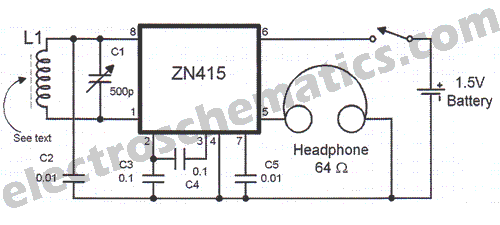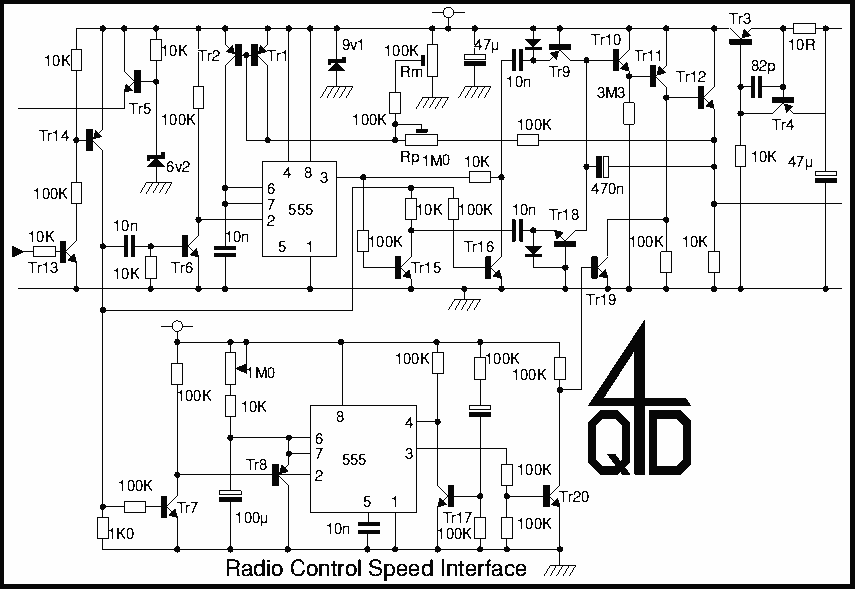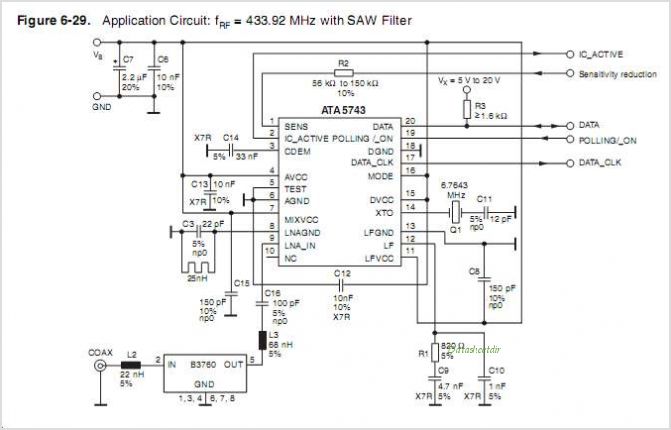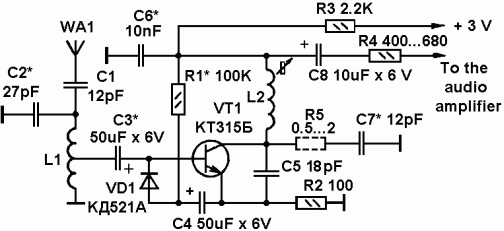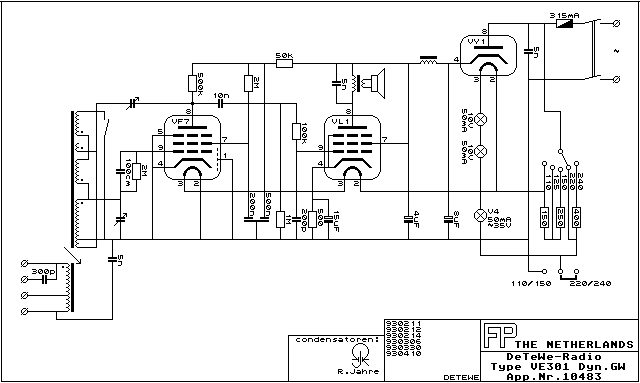
HAM RADIO SW RECEIVER
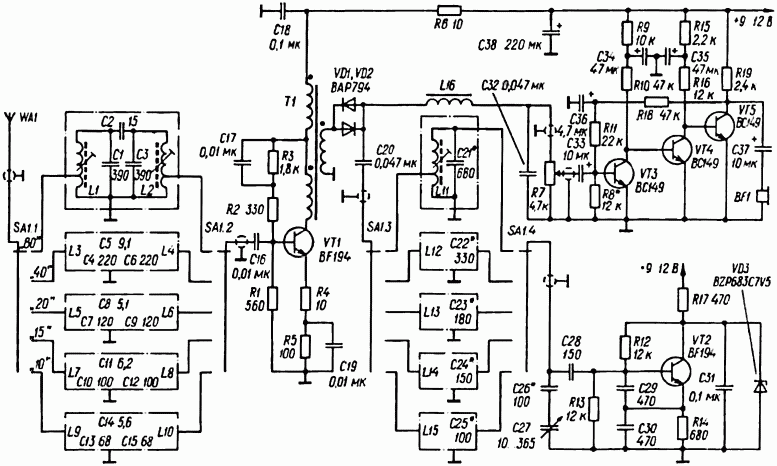
A simple radio receiver circuit is illustrated. This receiver is designed to capture signals from amateur radio stations operating in the shortwave (SW) bands of 10, 15, 20, 40, and 80 meters. The direct-conversion receiver comprises a set of input bandpass filters tuned to the center frequency of the amateur bands, a broadband RF amplifier using a transistor (VT1), a diode mixer (VD1, VD2), a local oscillator (VT2), and a three-stage audio frequency amplifier with high gain utilizing transistors (VT3-VT5). This audio amplifier drives headphones (BF1). A switch (SA1) is used to select between bands, connecting the filters to the RF amplifier input and the mixer to the appropriate resonant tank of the local oscillator. The local oscillator can be tuned using a variable capacitor (C27) and generates oscillations at a frequency that is half that of the received signals. A simple voltage regulator, based on a Zener diode (VD3), is implemented to minimize the local oscillator frequency's sensitivity to supply voltage variations.
The described radio receiver circuit operates as a direct-conversion receiver, allowing for efficient signal processing from amateur radio bands. The input bandpass filters are critical for isolating the desired frequency range, enhancing the receiver's ability to select specific amateur radio signals while rejecting out-of-band interference. The RF amplifier (VT1) boosts the incoming radio frequency signal, providing sufficient gain to ensure effective mixing in the diode mixer (VD1, VD2).
The mixer is pivotal in converting the RF signal to an intermediate frequency (IF), which is then processed by the audio frequency amplifier (VT3-VT5). This amplifier stage is designed for high gain to ensure that the audio signal is adequately amplified for headphone output (BF1), facilitating clear audio reception of the selected amateur radio transmissions.
The local oscillator (VT2) plays a crucial role in the frequency conversion process, generating a signal that is half the frequency of the incoming RF signal. This is achieved through the tuning capability provided by the variable capacitor (C27), allowing the user to adjust the local oscillator frequency to match the desired reception frequency.
The inclusion of the switch (SA1) for band selection simplifies the operation of the receiver, enabling users to easily switch between different amateur bands without complex adjustments.
The voltage regulator circuit, utilizing the Zener diode (VD3), ensures stable operation of the local oscillator by providing a consistent voltage supply, thereby reducing frequency drift that could occur due to variations in the supply voltage. This stability is essential for maintaining reliable reception across the various amateur bands.
Overall, the described circuit is a straightforward yet effective design for a radio receiver, making it suitable for amateur radio enthusiasts seeking to operate within the specified shortwave bands.A simple radio receiver circuit is shown in Fig. 1. This receiver is designed for reception of signals of amateur radio stations operating in the SW band of 10, 15, 20, 40 and 80 meters. This direct-conversion receiver consists of a set of an input bandpass filters tuned to the middle frequency of the amateur bands, a broadband RF amplifier based
on a transistor VT1, a diode mixer (VD1, VD2), a local oscillator (VT2) and a three-stage amplifier of audio frequency with high gain based on a transistors VT3-VT5. This amplifier is loaded with a headphones BF1. A switch SA1 is intended to switch between bands, it connects the filters to the input of the RF amplifier, and the mixer - to a corresponding resonant tank of the local oscillator.
The local oscillator is tunable by a variable capacitor C27 and it generates an oscillations with a frequency twice lower than the frequency of received signals. A simple voltage regulator is based on the Zener diode VD3 and it is used to reduce a dependence of the local oscillator frequency of a supply voltage variation.
🔗 External reference
The described radio receiver circuit operates as a direct-conversion receiver, allowing for efficient signal processing from amateur radio bands. The input bandpass filters are critical for isolating the desired frequency range, enhancing the receiver's ability to select specific amateur radio signals while rejecting out-of-band interference. The RF amplifier (VT1) boosts the incoming radio frequency signal, providing sufficient gain to ensure effective mixing in the diode mixer (VD1, VD2).
The mixer is pivotal in converting the RF signal to an intermediate frequency (IF), which is then processed by the audio frequency amplifier (VT3-VT5). This amplifier stage is designed for high gain to ensure that the audio signal is adequately amplified for headphone output (BF1), facilitating clear audio reception of the selected amateur radio transmissions.
The local oscillator (VT2) plays a crucial role in the frequency conversion process, generating a signal that is half the frequency of the incoming RF signal. This is achieved through the tuning capability provided by the variable capacitor (C27), allowing the user to adjust the local oscillator frequency to match the desired reception frequency.
The inclusion of the switch (SA1) for band selection simplifies the operation of the receiver, enabling users to easily switch between different amateur bands without complex adjustments.
The voltage regulator circuit, utilizing the Zener diode (VD3), ensures stable operation of the local oscillator by providing a consistent voltage supply, thereby reducing frequency drift that could occur due to variations in the supply voltage. This stability is essential for maintaining reliable reception across the various amateur bands.
Overall, the described circuit is a straightforward yet effective design for a radio receiver, making it suitable for amateur radio enthusiasts seeking to operate within the specified shortwave bands.A simple radio receiver circuit is shown in Fig. 1. This receiver is designed for reception of signals of amateur radio stations operating in the SW band of 10, 15, 20, 40 and 80 meters. This direct-conversion receiver consists of a set of an input bandpass filters tuned to the middle frequency of the amateur bands, a broadband RF amplifier based
on a transistor VT1, a diode mixer (VD1, VD2), a local oscillator (VT2) and a three-stage amplifier of audio frequency with high gain based on a transistors VT3-VT5. This amplifier is loaded with a headphones BF1. A switch SA1 is intended to switch between bands, it connects the filters to the input of the RF amplifier, and the mixer - to a corresponding resonant tank of the local oscillator.
The local oscillator is tunable by a variable capacitor C27 and it generates an oscillations with a frequency twice lower than the frequency of received signals. A simple voltage regulator is based on the Zener diode VD3 and it is used to reduce a dependence of the local oscillator frequency of a supply voltage variation.
🔗 External reference
